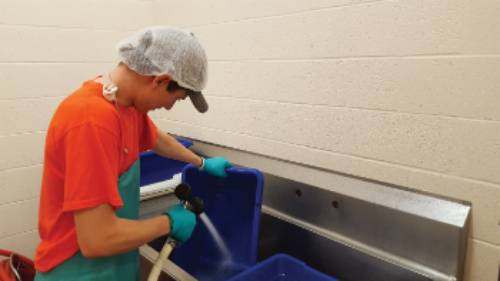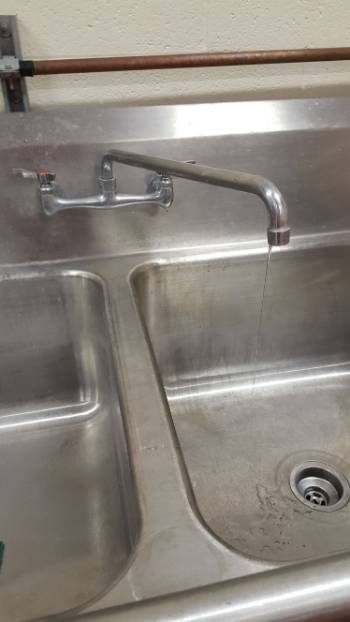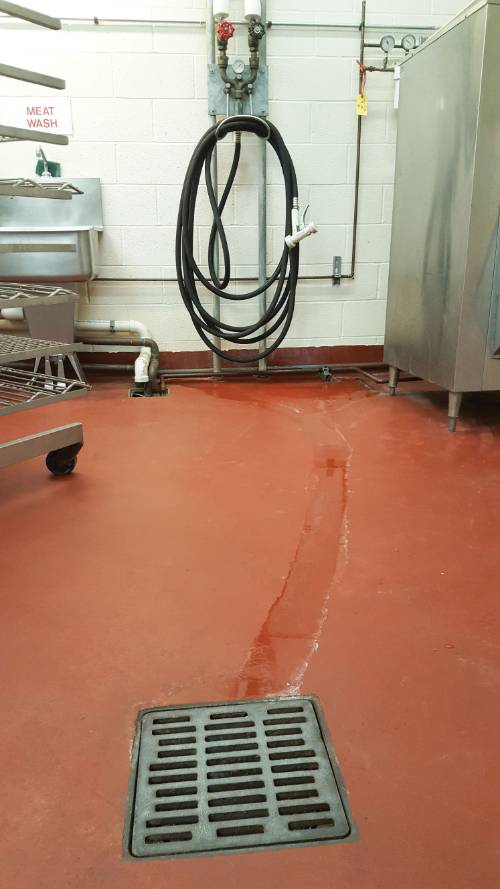Reducing Water Use in Food Processing
Introduction
Water is important to the food-processing industry for many reasons. In most foods, water is the primary ingredient or constituent. Water is extensively used in most food plants as a processing aid and for cleanup and sanitizing. Conservation and reuse of water saves money and reduces a food company’s exposure to rising water costs and potential shortages (Schug, 2016). The purpose of this fact sheet is to help food processors reduce water usage by introducing concepts, methods and practical examples of water conservation, recycling and reuse.
Determine Water Usage
One of the first steps in a water use reduction program is to develop an understanding of how water is currently being used in a food-processing facility. A water balance, or audit, may be conducted to track the input and output of water used throughout a facility. The balance should be comprehensive and may include the following areas or uses:
- Process operations such as cooling, cooking, size reduction, evaporation and cleaning.
- Utilities, such as steam and condensate losses.
- Leaks.
- Sanitary use.
- Waste streams.
- Laundry.
- Irrigation.
Refer to the resource section of this fact sheet for comprehensive guides on how to conduct a water balance.
Figure 1. Faucet leak on the three-compartment sink in a food processing facility
Minimizing Water Use
Four main areas in food-processing facilities should be considered for minimizing water use:
- Process;
- Equipment;
- Facilities; and
- Personnel
Each area is discussed separately below.
Process
Processes can be improved or changed to reduce water use. This section on reducing process water use is based on ideas described by Kim and Smith (2008).
Recycling
Local recycling happens when water is completely or partially recycled within a particular operation or process. An example would be a spray cooler for filled product containers, where water is used as a cooling medium. A counter-flow design facilitates water recycling from the last cooling section to a previous cooling section. A cooling tower can be incorporated into the system to reject heat.
Area recycling describes when water is reused in an operation separate from its original use. Reusing process water for lawn sprinkling is an example of area recycling of non-potable water.
Potable water reuse regulations have not been developed at the Federal level in the U.S. (American Water Works Association, 2016). Direct use of potable water is subject to a facilities’ quality and Hazard Analysis Critical Control Point (HACCP) plans and possibly state regulations. Public perception is a major factor for potable water reuse. Customers may not be prepared to accept recycled water as an ingredient, or in the manufacturing of the food products they purchase. For these and other reasons, the food industry has been slow to adopt systems reusing potable water in foods or in contact with foods.
Figure 2. Clamp-on ultrasonic flow sensor (model PDFM 5.1, Greyline Instruments, Inc, Massena, NY) used to accurately measure liquid flow in pipes.
Waterless Alternatives
Process alternatives that do not use water may be substituted for those that do. Dry milling is an alternative process to replace wet milling. Cleanup operations using dry ice, vacuums or sweepers to clean up solids are an alternative to water-washing. Use of a broom to push solids to a drain or pan is an alternative to using water for the same task. Waterless process alternatives can accrue major savings in water use.
Improved Process Control
Process controls can be used to improve the use of water. For example, a ball valve may be replaced with a gate valve to achieve improved control of water flow rates. Accurate water flow control may be difficult due to variations in supply water pressure. A pressure regulator can be added to the water supply line to reduce pressure variations and improve flow control downstream. A flow meter, control valve and controller can be added to a water line to more precisely control and record flow.
Recirculate Utilities
Steam and water used for heating and cooling are common in the food industry. To reduce water consumption, utilities can be recirculated instead of used once and discarded to the drain. For example, cooling water can be recovered, passed through a cooling tower and reused. Steam condensate should be recovered and circulated back to the boiler for reuse.
Improve Production Scheduling
Production scheduling can be organized to save water. For example, product changeover can be scheduled to eliminate or reduce cleaning steps between products. Tanks, pipelines, conveyors and process equipment can be designed and installed to accommodate multiple products processed one after another without significant cleaning or equipment changes between products. For example, chocolate pudding could follow vanilla, but not vice versa. Breaks can be staggered to reduce downtime and rinsing or cleaning requirements.
Batch vs. Continuous Operations
Batch operations often require more frequent cleaning cycles compared to continuous processes because empty equipment (e.g. tanks, hoppers and conveyors) may need to be cleaned between uses. Continuous operations often do not require cleaning until the end of a production run. Batching may also require cleaning of additional tanks and equipment.
Water Treatment
Hardness in water refers to the amount of minerals dissolved in the water. Hard water does not function optimally for process aid activities such as dissolving, rinsing, dispersing, diluting and separating because of the interference of the minerals. Hard water will require additional chemicals to achieve cleaning and sanitizing requirements compared to soft water. Use of a water softener to remove minerals can reduce water and chemical use by making the water more effective at cleaning and as a processing aid.
Equipment
Equipment can be improved or changed to reduce water use. This section reviews some of the possibilities for food-processing equipment improvement.
Improved Design
New equipment utilizing superior materials of construction, improved design concepts, controls,and materials handling may be much more efficient regarding water use than existing equipment. More efficient equipment will frequently result in other savings such as energy, labor and ingredients.
Monitoring Water
Equipment with water monitoring features will provide valuable feedback to operators and engineers for water use optimization. Flowmeters, temperature sensors, pressure sensors, water quality sensors (e.g. pH, dissolved oxygen, conductivity) and leak detectors are examples. New submetering systems use wireless technology and software to help track and allocate water use. Minimal or no supervision is required with most submetering systems and customized summary reports can be generated and distributed automatically.
Cleaning
Clean-In-Place systems used to clean and sanitize food-processing equipment and surfaces may save considerable amounts of water, energy, labor and chemicals compared to manual cleaning methods. Clean-In-Place units providing storage and recycling of cleaning fluids and rinse water will save significant amounts of water. A pigging system may be useful to clean solids from piping prior to cleaning with water. A “pig” is an object or tool that is inserted into a pipe to be cleaned. The pig fits tightly to the inside pipe diameter and is forced through a pipeline using compressed gas. The pig pushes standing product in the pipe to an outlet.
Repairs and Maintenance
Leaks and fouling are common reasons why excessive water is used in food plants. Equipment using water should be periodically examined and maintained to operate at peak performance. Spray nozzles and heat exchangers are especially sensitive to fouling. Machinery that is broken or operating out of specification can be wasteful of water and other materials.
Separation
Consider the use of separators to remove solids from water for potential reuse. Screens, settling tanks, filters, membranes and centrifuges may be appropriate. Recovered solids may be reused, sold or discarded.
Manual Water Hoses
Install low-flow nozzles and automatic shut-off valves. Install ergonomic and efficient nozzles for the intended job.

Figure 3. Using a water hose in a food-processing facility. A lower-pressure, lower-flow system that is lighter and easier to operate would save water, energy and reduce splashing. An automated wash system for containers would save on labor, water and energy costs.
Facility
A food-processing facility can be redesigned or improved or to reduce water use. This section reviews some of the possibilities for food-processing facility improvement.
Improved Design
Layout of a food-processing facility should incorporate the required space and height for equipment to gravity-drain to facilitate Clean-In-Place systems and water reuse tanks. Strategic use of maintenance alleys and spaces, utility corridors, electrical rooms and similar areas can reduce the amount of wash-down required in a facilities-process area. The intentional design of the ventilation system(s) can reduce dust and foreign materials entering the facility, reducing the need for cleanup. Floor slope, drain locations, doors, curbs, surface penetrations, windows, materials of construction and other architectural features can impact the need and requirements for water used in cleaning.
Monitoring Water
Many food-processing companies rely on water meters supplied by the utility provider for monitoring overall water consumption. This reliance can work in the company’s favor if the meter underestimates the amount of water being consumed. The converse can also be true. An accurate backup measurement of facility water use can be a wise investment for a large water user, especially when the municipal sewage bill is based on water consumption.
Water meters on major branch lines in the food processing facility can be useful for overall water tracking and reduction purposes. Meters can help managers quickly identify problem areas and changes in operations. Access to read meters are important features when specifying meters.
Catastrophic leaks due to plumbing failures can be expensive. Water cost, facility downtime, equipment repair or replacement and product loss are among the possible consequences. A system to detect leaks, or excessive water flow, with a means of shutting down or bypassing the water supply is appropriate where catastrophic leaks may occur.
Cleaning
Clean-In-Place systems used to clean and sanitize food-processing facilities and spaces may save considerable amounts of water, time, energy and chemicals compared to manual cleaning methods. Savings are increased when cleaning fluids are recirculated and stored for use in subsequent cleaning cycles.
Repairs and Maintenance
Pipes, gutters, tanks, cracked pavement, peeling surface treatments, sprung doors, leaky seals and gaskets are common reasons for excessive water use in cleaning food plants. Surfaces should be periodically examined and maintained to facilitate cleaning. Doors, windows and screens should be maintained. The ceiling and roof must be free of debris and sealed.
Plumbing Design
The distance of pipe runs can be minimized. Hot and chilled water lines should be insulated to prevent unwanted heat loss/gain. Insulation in wash-down areas should be completely sealed and waterproof. On long plumbing runs transporting hot or chilled water to users, a recirculation line or heat tracing may be installed to prevent wastage while waiting for water to reach the desired temperature. Water pressure should be set and maintained in lines at levels matching the use requirements. Low or excessive water pressure may result in waste. Plumbing should be sloped to facilitate self-emptying and reclaiming of water.
Personnel
Training and empowerment of personnel can be effective tools to reduce water use. A culture of water conservation and responsibility of use is desired. This section describes two methods enabling personnel to reduce water use.
Training
Focused training on standard operating procedures including the use of water can result in water savings. Training must include motivation for desired responses (see empowerment subtopic below). For example, personnel using hoses to wash down work areas must be trained on the importance of turning off hoses when not in use. An understanding of the amount of water wasted, the cost and environmental consequences are often sufficient motivation. The employee should also have the means available to make the choice for water savings simple.
Empowerment
According to a Gallup study on the American workplace (2013), organizations with 90% of their workforce engaged have 147% higher earnings per share. Employees engaged with the entire system and have a measure of control over their areas of responsibilities are more likely to identify and solve problems. Best practices for employee engagement are summarized by Engagement@Harvard (2016). Employee empowerment may be one of the best means of solving water problems and reducing use.
Figure 4. Leaky hose nozzle in a food processing facility. Mineral deposits from the water trail on the floor are visible.
Conclusion
This fact sheet outlines proactive steps for reducing water use in the food industry. The initial step is to perform a water balance on the facility. Next, a water minimization strategy can be developed by focusing on process, equipment, facility and personnel. The nature and results of the strategy will be unique to each situation and environment. A variety of methods can be employed to develop and implement savings by individuals, departments, teams, suppliers, and consultants. If you would like guidance in the development of your water reduction and management strategy, please call the Robert M. Kerr Food & Agricultural Products Center (405-744-6071) or e-mail fapc@okstate.edu to request assistance.
Resources
- GE Water & Process Technologies, J. P. McIntyre. Industrial Water Reuse and Wastewater Minimization.
- H. DeLonge. 2008. The Water Audit: a Tool to Manage Operational Costs and Performance, Food Quality & Safety Magazine.
- Klemes, R. and J-K. Kim (editors). 2008. Handbook of Water and Energy Management in Food Processing. Woodhead Publishing Ltd., Cambridge, England. 1029 pg.
- Long Beach Water Department, Water Conservation Tips, A 10 Step Approach for Your Business
- Minnesota Technical Assistance Program for food processors lists five fact sheets, two case studies and three intern studies devoted to water conservation.
- South Florida Water Management District Water Supply Development Section, West Palm Beach, Florida, Water Efficiency and Self-Conducted Water Audits at Commercial and Institutional Facilities, 2nd ed.:
- Water Minimisation in the Food and Drink Industry
- Water Recovery and Reuse: Guideline for Safe Application of Water Conservation Methods in Beverage Production and Food Processing.
References
American Water Works Association. 2016. Potable Reuse 101, an Innovative and Sustainable Water Supply Solution. Accessed on September 6, 2016.
Engagement@Harvard. 2016. Engagement Toolkit for Managers and Leaders. Accessed on August 31, 2016.
Gallup. 2013. State of American Workplace. Accessed on August 31, 2016.
Kim, J. and R. Smith. 2008. Methods to minimize water use in food processing.
Schug, D. 2016. Reducing water usage in food and beverage processing. Food Engineering Magazine, April issue
Tim Bowser
Food Process Engineer



